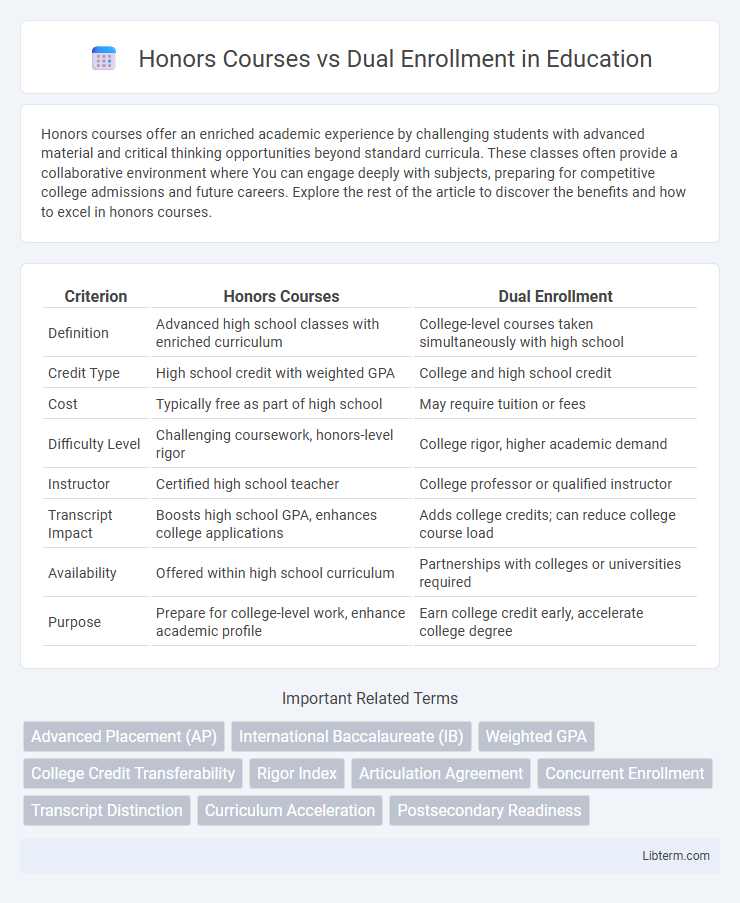Honors courses offer an enriched academic experience by challenging students with advanced material and critical thinking opportunities beyond standard curricula. These classes often provide a collaborative environment where You can engage deeply with subjects, preparing for competitive college admissions and future careers. Explore the rest of the article to discover the benefits and how to excel in honors courses.
Table of Comparison
| Criterion | Honors Courses | Dual Enrollment |
|---|---|---|
| Definition | Advanced high school classes with enriched curriculum | College-level courses taken simultaneously with high school |
| Credit Type | High school credit with weighted GPA | College and high school credit |
| Cost | Typically free as part of high school | May require tuition or fees |
| Difficulty Level | Challenging coursework, honors-level rigor | College rigor, higher academic demand |
| Instructor | Certified high school teacher | College professor or qualified instructor |
| Transcript Impact | Boosts high school GPA, enhances college applications | Adds college credits; can reduce college course load |
| Availability | Offered within high school curriculum | Partnerships with colleges or universities required |
| Purpose | Prepare for college-level work, enhance academic profile | Earn college credit early, accelerate college degree |
Understanding Honors Courses
Honors courses offer rigorous academic challenges within the high school setting, designed to deepen subject knowledge and critical thinking skills. These courses often include accelerated pacing and enriched content, fostering a more immersive learning experience compared to regular classes. Understanding Honors courses helps students choose paths that enhance college readiness and highlight academic excellence on transcripts.
What Is Dual Enrollment?
Dual Enrollment allows high school students to simultaneously earn college credits while completing their high school diploma, providing a head start on higher education. This program partners with local colleges or universities, giving access to college-level courses and instructors, often at reduced or no cost. Honors Courses, in contrast, are advanced high school classes that challenge students within the high school curriculum but do not typically confer college credit.
Key Differences Between Honors and Dual Enrollment
Honors courses emphasize advanced, rigorous curriculum within a high school setting, designed to deepen subject knowledge and critical thinking skills, often earning weighted GPA benefits. Dual enrollment allows high school students to take college-level courses for actual college credit, providing direct exposure to college academics and potentially reducing time and cost for a degree. While honors courses are school-based and focused on preparatory excellence, dual enrollment bridges high school and college by enrolling in accredited postsecondary institutions.
Academic Rigor: Honors vs Dual Enrollment
Honors courses provide advanced curriculum within the high school setting, emphasizing critical thinking, analytical writing, and in-depth subject mastery. Dual enrollment courses enable students to earn college credits by taking actual college classes, offering exposure to college-level expectations and learning environments. Both pathways demonstrate academic rigor, but dual enrollment often involves greater intellectual challenges due to the integration with college standards and assessment methods.
College Credit Opportunities
Honors courses offer college-level rigor within a high school setting but typically do not grant direct college credit, instead enhancing GPA and preparing students for advanced study. Dual enrollment programs allow high school students to earn actual college credits by taking courses at a partnering college, providing a head start on post-secondary education and potential tuition savings. The college credit from dual enrollment is generally transferable to many institutions, whereas honors course benefits are primarily academic recognition on transcripts.
Impact on High School GPA
Honors courses typically weigh more heavily in GPA calculations, often using a 4.5 or 5.0 scale, which can boost a high school student's GPA compared to standard classes. Dual enrollment courses, taken at a college level, may or may not impact the high school GPA depending on the school's policy, but they provide college credits that enhance academic transcripts. Students should verify how their high school assigns GPA weight to dual enrollment credits to maximize the impact on their academic record.
College Admissions Considerations
Honors courses demonstrate a student's ability to tackle rigorous academic challenges, showcasing commitment and subject mastery that is highly valued by college admissions committees. Dual enrollment offers the advantage of earning actual college credits while still in high school, reflecting readiness for postsecondary coursework and potentially reducing college costs. Admissions officers evaluate both options for their impact on GPA and course rigor, with colleges often favoring dual enrollment credits that transfer directly to degree programs.
Flexibility and Scheduling Challenges
Honors courses often follow a set academic calendar within the high school, limiting flexibility for students balancing extracurriculars or part-time jobs, whereas dual enrollment programs offer more adaptable scheduling options by aligning with college course timetables. However, dual enrollment may require commuting to college campuses or managing online college-level workloads, posing unique challenges compared to the structured environment of honors courses. Both options demand careful time management but dual enrollment frequently provides greater control over course selection and timing.
Costs and Financial Implications
Honors courses often carry no additional tuition costs beyond standard school fees, making them financially accessible for most students. Dual enrollment programs may involve tuition expenses charged by the partnering college or university, potentially requiring payment per credit hour or course. Families should evaluate potential savings on college tuition versus upfront costs when considering dual enrollment as a cost-effective strategy.
Choosing the Best Path for Your Goals
Honors Courses offer rigorous, in-depth study within your high school, enhancing critical thinking and subject mastery that appeal to colleges. Dual Enrollment provides college credits by taking actual college classes, accelerating your academic progress while exposing you to the college environment. Selecting the best path depends on your academic goals, time management skills, and whether you prioritize college credit accumulation or challenging coursework.
Honors Courses Infographic

 libterm.com
libterm.com